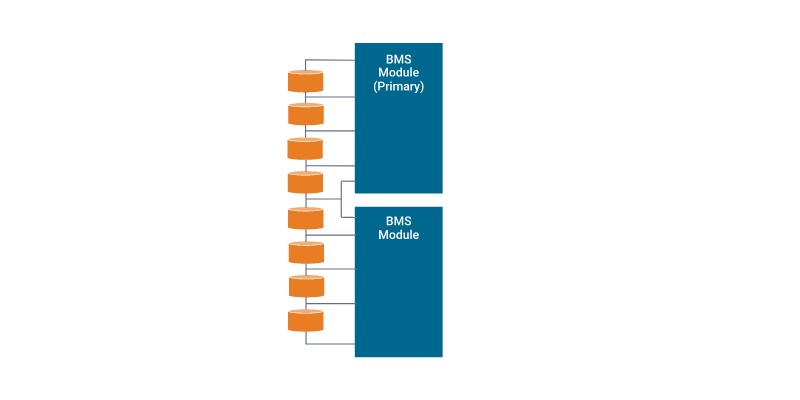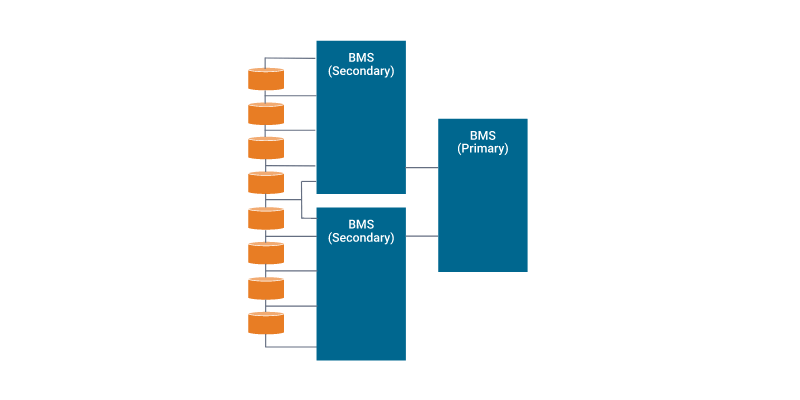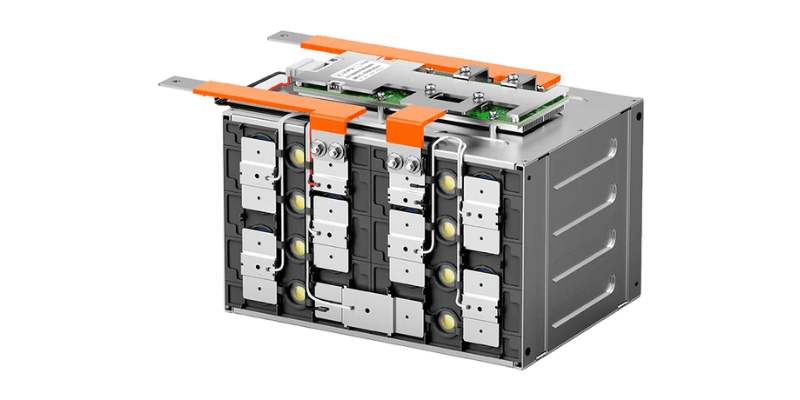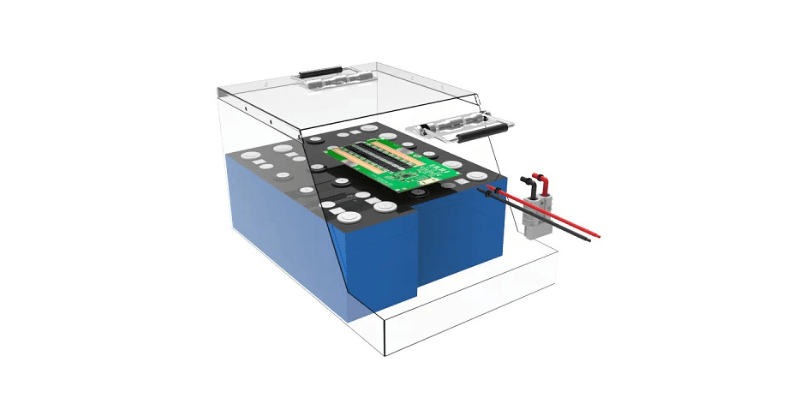리튬 이온 배터리는 다음에 있습니다 최고 에너지 밀도, 배터리 팩을 손상시킬 수있는 조건에 취약 할 수 있습니다. 그렇기 때문에 이러한 손상 조건을 방지하기 위해 배터리 관리 시스템이 필요합니다.
정의
에이 배터리 관리 시스템(BMS) 충전식 배터리의 충전 및 방전을 모니터링하고 조절하는 전자 회로입니다.
배터리가 안전 한도 내에서 작동하도록 보장하며, 이는 배터리의 성능과 수명에 중요합니다.
배터리 관리 시스템의 유형
배터리 관리 시스템은 간단한 것에서 복잡한 것까지 다양한 기술을 통합하여 배터리 관리에 걸쳐 있습니다. 이러한 시스템은 토폴로지로 분류 할 수 있습니다 – 배터리 팩의 셀 또는 모듈에서 설치 및 작동 방식.
중앙 집중식 BMS 아키텍처

배터리 팩의 중앙 집중식 BMS는보다 작고 경제적 인 것과 같은 장점을 제공합니다.
그러나 단점도 있습니다.
모든 배터리가 직접 연결되면 BMS에는 수많은 포트가 필요하므로 대형 배터리 팩에 복잡한 배선 및 케이블이 필요합니다. 이것은 문제 해결 및 유지 보수를 복잡하게 만듭니다.
모듈 식 BMS 토폴로지

이러한 유형의 BMS의 경우 시스템은 복제 된 모듈로 나뉘며 각각 배터리 스택의 할당 된 부분에 연결됩니다.
기본 BMS 모듈은 하위 모듈을 감독하고 상태를 모니터링하고 다른 장비와 통신 할 수 있습니다. 이 복제 된 모듈성은 문제 해결, 유지 보수 및 더 큰 배터리 팩으로의 확장을 단순화합니다.
그러나이 접근법은 전체 비용을 약간 증가시키고 응용 프로그램에 따라 사용되지 않은 기능을 중복시킬 수 있습니다.
1 차/하위 BMS

모듈 식 토폴로지와 유사하게,이 경우 노예는 주로 측정 정보를 중계하는 반면 마스터는 계산, 제어 및 외부 통신을 처리합니다.
슬레이브 기능은 더 간단하여 모듈 식 유형과 같이 오버 헤드가 적고 미사용 기능이 적어 비용이 줄어 듭니다.
분산 된 BMS 아키텍처

분산 된 BMS 설계는 다른 토폴로지와 다릅니다.
이들은 모니터링 셀 또는 모듈에 직접 배치 된 제어 보드에 모든 전자 하드웨어를 통합합니다. 이렇게하면 케이블을 BMS 모듈 사이의 몇 가지 센서 및 통신 와이어로 줄입니다. 각 BMS는 더 자체적으로 포함되어 있으며 필요에 따라 계산 및 통신을 처리합니다.
그러나 BMS가 차폐 모듈 내에있는 것처럼이 통합 된 형태는 문제 해결 및 유지 보수를 더욱 어렵게 만들 수 있습니다.
배터리 팩의 BMS 장치 수 증가로 인해 비용도 더 높습니다.
배터리 관리 시스템의 기능은 무엇입니까?
배터리 관리 시스템은 시스템 요구에 따라 전류, 전압 및 온도를 측정하는 배터리 셀 매개 변수를 모니터링하고 관리합니다. 셀의 균형을 맞추고 배터리의 충전 상태 (SOC) 및 건강 상태 (SOH)를 계산합니다.
BMS는 충전 및 배출 공정을 제어하여 과전압, 과잉 온도 및 기타 위험을 방지합니다. 배터리와 사용자 안전을 보장하는 데 필수적입니다.
통신 함수는 내부 BMS 구성 요소와 외부 장치 간의 신호를 전송합니다. BMS는 대시 보드 또는 HMI (Human-Machine Interfaces)에 데이터를 표시 할 수 있습니다. 통합 또는 별도의 충전기와의 연결은 유선 또는 무선 일 수 있습니다.
리튬 이온 배터리에 배터리 관리 시스템이 중요한 이유
리튬 이온 배터리에는 가연성 액체 전해질이 있으므로 화재를 방지하기 위해 최적으로 그리고 안전 제한 내에서 작동해야합니다.

배터리 관리 시스템은 어떻게 작동합니까?
센서에 연결된 배터리 관리 시스템은 각 셀의 전압, 전류 및 온도를 모니터링합니다. 데이터를 분석하여 세포가 설정된 매개 변수 내에서 작동하도록하고 문제를 해결하기 위해 조치를 취합니다.
BMS는 셀이 과열되면 냉각 시스템을 제어하여 배터리 팩 온도를 낮추기 위해 냉각 시스템을 제어합니다. 또한 동일한 전압을 유지하기 위해 에너지를 전달함으로써 세포의 균형을 유지합니다.
BMS는 데이터를 기록하여 배터리 팩과 전반적인 건강에 유입되고 종료되는 에너지를 평가합니다. 리튬 이온 배터리는이 데이터를 사용하여 배터리가 배출 된시기를 감지 한 다음 종료합니다. 그렇기 때문에 납산 배터리와 동일한 죽음 표지판을 나타내지 않고 간단히 꺼집니다.
배터리 관리 시스템의 이점은 무엇입니까?
BMS 혜택은 다음과 같습니다.
- 특히 큰 기능 안전 리튬 이온 배터리 팩, 화재 및 손상 방지
- 안전한 작동 한도 내에서 셀을 관리하여 배터리 수명 및 신뢰성 확장
- 배터리 성능 및 범위를 최적화합니다 셀 밸런싱
- 배터리 상태에 대한 진단, 데이터 수집 및 통신 제공
- 배터리 시스템을 보호하여 전체 비용 및 보증 청구 감소

배터리 관리 시스템에서 제공하는 보호
배터리 관리 시스템의 보호는 다음과 같습니다.
아래 및 과장
BMS는 리튬 이온 배터리 셀이 과충전 (셀 전압이 너무 높아짐) 또는 과잉 차저 (셀 전압이 너무 낮아지면서)로 인한 손상을 방지합니다. 배터리에 해를 끼칠 수있는 전압 및 과잉 상황을 방지합니다.
극한의 온도
리튬 이온 배터리 안전 및 안정성은 온도 제어에 따라 다릅니다. 임계 한도를 초과하면 발생할 수 있습니다 열 폭주 그리고 험담 할 수없는 화재.
BMS는 온도를 모니터링하고 냉각 팬을 제어하며 셀을 차단하여 적절한 조건을 유지할 수 있습니다.
반바지로부터 보호
내부 및 외부 반바지로 인해 열 런 어웨이가 발생할 수 있습니다.
따라서 반바지로부터 보호는 배터리 관리 시스템의 중요한 부분입니다.

Holo 배터리 내장 배터리 관리 시스템
Holo 배터리는 단락, 고전류, 온도 극한 및 전압 문제와 같은 일반적인 배터리 고장 원인을 방지하기위한 맞춤형 BMS 옵션을 제공합니다.
BM은 설정에 맞게 다양한 크기로 제공되며 배터리 수명을 최적화하고 성능 데이터를 제공합니다.
소규모 장치 또는 대형 에너지 시스템에 전원을 공급하든 신뢰할 수 있고 사용자 친화적 인 BMS 솔루션을 제공합니다.
결론
리튬 이온 배터리는 많은 이점을 제공하지만 안전 및 최적의 수명을 보장하기 위해 모니터링, 관리 및 밸런싱이 필요합니다. 배터리 관리 시스템은 핵심이므로 배터리를 안전하고 효율적으로 작동시켜 자신감을 가지고 사용할 수 있습니다.
관련 기사:

